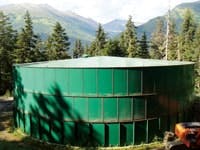Each winter, water operators in northern climates face a range of challenges due to cold weather, including main breaks and equipment outages. While these emergencies come without warning, they are obvious and visible when they do occur. But in other parts of the water distribution system, cold weather can create a risk that is hidden from view: ice accumulation inside water storage tanks. Often, when operators realize they have a problem with ice in their tanks, it is too late—the tank’s interior is damaged or the wall is punctured.
The city of Anchorage, Alaska, is accustomed to cold weather and the operational challenges it brings. The city’s water system includes about 800 miles of pipe and 20 water storage tanks. In the winter, the Anchorage Water and Wastewater Utility (AWWU) collaborates with Anchorage Municipal Light and Power (ML&P), using waste heat from the power generation process to warm the water in its distribution system and prevent freezing in its water storage tanks.
In addition, AWWU vigorously cycles water through its tanks, aiming for at least 30% daily turnover. While this strategy sometimes requires more pumping and tank turnover than would be necessary for normal operations, for the most part, it has kept the ice issue under control.
Unfortunately, the community of Girdwood, Alaska, which also is a part of AWWU but 30 miles to the east, cannot use water warmed by ML&P. Girdwood has a single 1-million-gal bolted ground-level storage tank, and in order to provide adequate fire reserves, AWWU can only cycle the tank between 16 and 22 ft. The two wells that feed the Girdwood system typically output water that is 40°F in the winter and this, combined with the lower turnover, leads to ice formation inside the tank. During the tank’s drain cycle, operators could sometimes hear ice chunks breaking free from the walls and splashing into the water below.
ROV inspections of the tank interior showed some damage to the interior tank coating, especially around the central column that supports the roof. In order to prevent corrosion of the exposed tank interior, operators took the tank down for closer inspection and coating repair.
Closer Inspection
With the tank drained, operators discovered that the interior damage was far worse than the ROV inspection had revealed. In addition to significant areas of coating damage, ice had twisted the center column out of place. While the cost of repairing the coating damage and realigning the column came to roughly $20,000, the largest expense by far came from taking the tank offline and providing temporary storage and control—roughly $100,000.
Eager to explore options for eliminating future ice formation in the Girdwood tank, operators at AWWU researched various strategies. Insulating tanks can reduce the heat lost during cold winter months. But insulation is expensive—about $200,000 for a tank of this size—and insulation does not prevent ice formation; it only reduces the rate of ice accumulation. Finally, operators hit upon a novel approach that they thought might address ice formation once and for all: active mixing. “A tank mixer was a lot cheaper than tank insulation, and with insulation, you still get ice,” said Mark Corsentino, project engineer for AWWU.
Keeping Tanks Ice Free
Submersible active mixers prevent ice formation by constantly circulating water throughout the tank. Without mixing, tanks can become thermally stratified during the winter. Liquid water becomes denser as it warms from freezing to about 5°F, so the coldest water in a tank floats to the top. Active mixers push the heavier, warmer water at the bottom up to the top and keep the entire contents of the tank thermally uniform, preventing ice formation.
Installation of the mixer was relatively simple, only requiring 110-V electrical power, which was available at the tank. “The installation of the mixer was quite easy,” said Richard Steckel, former water superintendent for the town of Girdwood. “Some of our guys were surprised at how small the device was. They thought it looked like a margarita maker.”
After installation, AWWU staff monitored the performance of the mixer by opening the hatch and inspecting the interior. Despite extremely cold temperatures during the 2010-2011 winter (with a number of sub-zero days in February 2011) the tank remained ice free.
An Added Benefit of Mixing
The following spring, power to the main well that supplied the Girdwood system was lost and operators were forced to rely only on the other well. The operators dreaded this switch because, in the past, use of this backup well water typically triggered numerous water quality complaints due to elevated iron and manganese levels and the smell associated with hydrogen sulfide (H2S). But for the period of time that Girdwood was supplied from this well, operators received no water quality complaints. The mixing system was able to aerate the water in the tank, and the H2S was removed. “Nobody even knew we had lost a well,” Steckel said.
With two winter seasons behind it, the city of Anchorage now is exploring the use of active mixing systems in more of its tanks. Active mixing, in addition to some of the operational strategies it already employs, will allow AWWU to keep more stored water in reserve for emergency response and may allow it to reduce some of the more energy-intensive, pump-around strategies on which it had relied in the past. Further, by preventing ice dam- age and reducing the cost and frequency of tank repainting, which can only be done during peak demand in summer months, AWWU can save money and prevent operational headaches.
Download: Here



